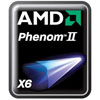
890FXA-UD7 vs. CrossHair IV Formula with X6 1090T - AMD Strikes Back?

Shortly after the debut of the Intel Core i7 980X EE, AMD also broke into the six-core processor market. The series, born under considerable pressure, is the swan song of the K10.5 architecture, but this year's Fusion, as well as the next-generation microarchitecture, the Bulldozer promised for 2011, may still cause unpleasant surprises for Intel.

Thuban can be called a giant without exaggeration, as the (presumably) monolithic chip with 904 million transistors has a floor area of 346 mm2. Presumably because AMD hasn’t officially announced the number of transistors, there’s no doubt that Phenom II X45 models with 6nm SOI manufacturing technology can’t pinch the Intel Core i7 series in terms of power per square millimeter and number of transistors.

Family | Model | Clock / Turbo Core | Seeds | L2- / L3-Cache | Encapsulation | TDP |
Phenom II X6 | 1090T | 3,2 / 3,6 GHz | 6 | 3MB / 6MB | AM3 / AM2 + | 125 W |
Phenom II X6 | 1055T | 2,8 / 3,3 GHz | 6 | 3MB / 6MB | AM3 / AM2 + | 125 W |
Phenom II X6 | 1055T | 2,8 / 3,3 GHz | 6 | 3MB / 6MB | AM3 / AM2 + | 95 W |
Thuban cores can each manage 512 KB of second-level cache and a shared 6 MB of third-level cache. At this point, we can unfortunately rightly assume that we are “only” opposed to the Phenom X4, a simple extension. It is likely that the physical parameters of the chip will prevent an increase in L3 and its consumption indicators will prevent an increase in the speed of the cache and HyperTransport. Simply put, Thuban core CPUs are served by quad-core Deneb data buses, which is not exactly an optimal condition, virtually carrying performance scaling issues.

The main virtue of six-core Phenom processors is clearly its wide compatibility. Built-in DDR2, DDR3 memory controller, and Socket AM2 +, AM3 support all help keep as many users in the company as possible in the event of a future system expansion. Looking a little ahead, with the AMD Bulldozer architecture, the AM3 enclosure is especially appealing to those planning to put together a truly timeless configuration.

The Turbo Core technology that appears in Thuban-based processors, like Intel’s Turbo Boost solution, is a form of automatic tuning. AMD has solved this by loading 3 cores or less, and the other 3 cores will be idle, meaning its frequency will drop to 800 MHz. The energy saved in this way can be used for the working cores with some tension and an increase in clock speed. The clock increase therefore depends on the load on the processors, up to 500 MHz.
Phenom II X6 1090T
In practice, the Turbo Core procedure can sometimes fall into its own trap. Programs running on one or two threads do not necessarily mean that the other processor cores are idle. Operating system background applications can often prevent overclocking. According to Anandtech measurements, the Phenom II X6 1090T caused a performance increase of about 2-10 percent.
Thanks to the low k constant (low k) insulating layer used at Thuban, the amount of leakage current was significantly reduced and a stepping change was made in parallel. The name of the new revision is E0. AMD has definitely done well at this point, as the clock speed of the fastest six-core processor is only 200 MHz lower than that of the fastest quad-core processor, the Phenom II X4 965 BE, while both are in the 125-watt TDP power class. Thanks to the improvements, despite the 45 nm bandwidth, energy efficiency has greatly increased.

















